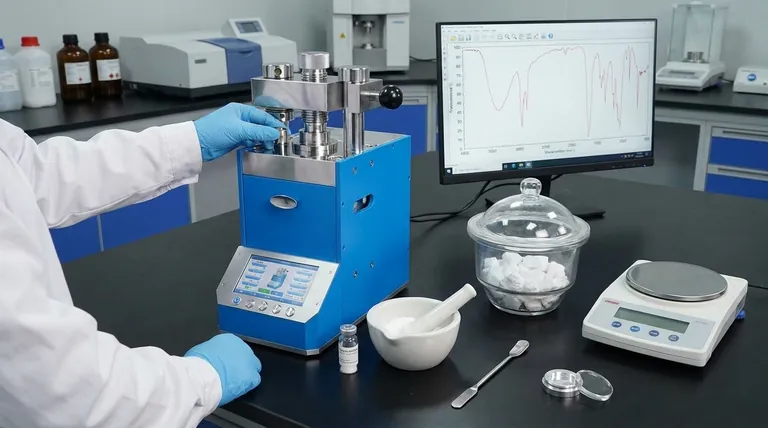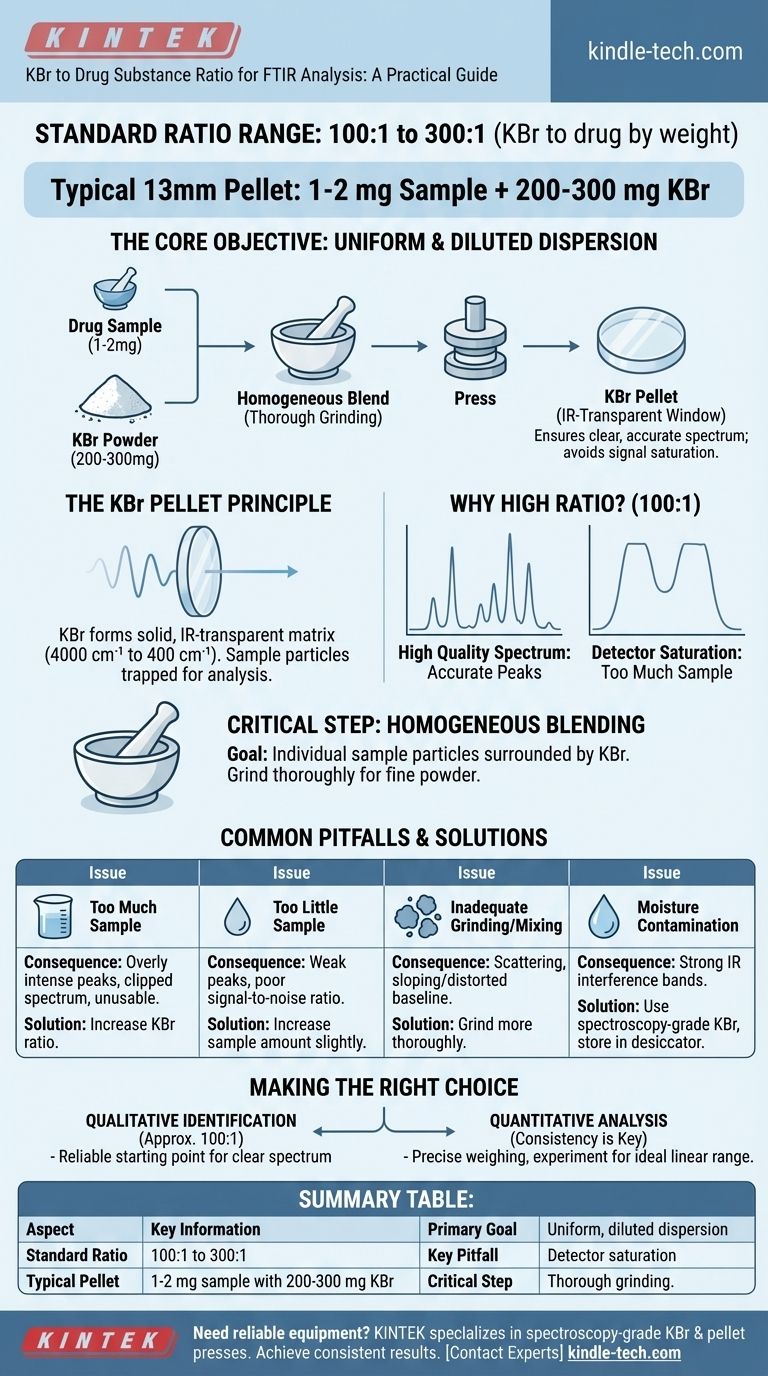Il rapporto standard tra bromuro di potassio (KBr) e principio attivo per l'analisi FTIR è tipicamente compreso tra 100:1 e 300:1 in peso. Per una pastiglia standard da 13 mm, questo si traduce spesso nell'uso di 1-2 mg di campione con 200-300 mg di KBr.
L'obiettivo principale non è semplicemente raggiungere un rapporto specifico, ma creare una dispersione uniforme e sufficientemente diluita del campione all'interno della matrice di KBr. Ciò garantisce che lo spettro infrarosso risultante sia chiaro, accurato e privo di artefatti comuni come la saturazione del segnale.

Il Principio alla Base del Metodo della Pastiglia di KBr
La tecnica della pastiglia di KBr è un metodo comune di preparazione del campione per l'analisi di campioni solidi mediante spettroscopia FTIR. L'intero processo è progettato per sospendere l'analita solido in una matrice trasparente alle radiazioni infrarosse.
Il Ruolo del KBr come Matrice
Il bromuro di potassio (KBr) è un sale di alogenuro alcalino trasparente alla luce infrarossa nell'intervallo di analisi tipico (da 4000 cm⁻¹ a 400 cm⁻¹).
Quando viene pressata sotto alta pressione, la polvere di KBr forma un disco solido simile al vetro. Mescolando una piccola quantità del tuo principio attivo nel KBr, intrappoli efficacemente le particelle del campione all'interno di questa finestra trasparente all'IR per l'analisi.
Perché è Necessario un Rapporto Elevato
Un elevato rapporto di KBr rispetto al campione, come 100:1, è fondamentale per ottenere uno spettro di alta qualità.
Se il campione è troppo concentrato, l'assorbimento della luce infrarossa sarà troppo forte. Ciò provoca l'appiattimento e l'allargamento dei picchi nello spettro, un fenomeno noto come saturazione del rivelatore. Uno spettro saturato non è quantitativamente accurato e può oscurare caratteristiche spettrali importanti.
Ottenere una Dispersione Uniforme
Il passaggio più critico nella preparazione del campione è garantire che il principio attivo sia miscelato in modo omogeneo con il KBr.
L'obiettivo è che le singole particelle del tuo campione siano completamente circondate dalla matrice di KBr. Ciò si ottiene tipicamente macinando insieme i due componenti accuratamente con mortaio e pestello, assicurando una polvere fine e uniforme prima della pressatura.
Comprendere i Compromessi e le Insidie Comuni
Sebbene 100:1 sia una linea guida standard, il rapporto ottimale può dipendere dall'assorbibilità del tuo campione specifico. Comprendere i potenziali problemi è fondamentale per la risoluzione dei problemi dei risultati.
Troppo Campione (Basso Rapporto KBr)
L'uso di troppo campione porta a picchi di assorbanza eccessivamente intensi. Il rivelatore non è in grado di misurare la luce che passa, causando l'apparizione di picchi "troncati" in cima. Ciò rende lo spettro inutilizzabile per qualsiasi forma di misurazione quantitativa.
Troppo Poco Campione (Alto Rapporto KBr)
Se il campione è troppo diluito, i picchi risultanti saranno molto deboli. Ciò porta a un cattivo rapporto segnale-rumore, dove i picchi caratteristici del tuo farmaco sono difficili da distinguere dal rumore di fondo dello strumento.
Macinazione o Miscelazione Inadeguate
Una miscelazione scarsa è una fonte comune di errore. Se il campione non viene macinato e disperso finemente, grumi di principio attivo possono causare la diffusione del fascio IR. Ciò si traduce spesso in una linea di base inclinata o distorta, rendendo difficile l'identificazione dei picchi.
Contaminazione da Umidità
Il KBr è igroscopico, il che significa che assorbe facilmente l'umidità dall'atmosfera. L'acqua ha forti bande di assorbimento IR che possono interferire con il tuo spettro. Utilizzare sempre KBr di grado spettroscopico che è stato conservato in un essiccatore o in un forno di essiccazione.
Fare la Scelta Giusta per la Tua Analisi
Il tuo obiettivo analitico specifico ti aiuterà a guidare la tua preparazione.
- Se il tuo obiettivo principale è l'identificazione qualitativa: Un rapporto di circa 100:1 (ad esempio, 2 mg di campione in 200 mg di KBr) è un punto di partenza affidabile per produrre uno spettro chiaro e di alta qualità.
- Se il tuo obiettivo principale è l'analisi quantitativa: La coerenza è fondamentale. Devi pesare con precisione i tuoi componenti e potresti dover sperimentare per trovare un rapporto che mantenga i tuoi picchi di assorbimento principali all'interno dell'intervallo lineare ideale dello strumento.
In definitiva, la preparazione corretta è quella che produce uno spettro chiaro e riproducibile con picchi nitidi e ben definiti per la tua sostanza specifica.
Tabella Riassuntiva:
| Aspetto | Informazioni Chiave |
|---|---|
| Intervallo di Rapporto Standard | Da 100:1 a 300:1 (KBr rispetto al farmaco in peso) |
| Pastiglia Tipica (13mm) | 1-2 mg di campione con 200-300 mg di KBr |
| Obiettivo Principale | Creare una dispersione uniforme e diluita per uno spettro chiaro |
| Insidia Principale da Evitare | Saturazione del rivelatore dovuta a troppo campione (basso rapporto) |
| Passaggio Critico | Macinazione accurata per una miscelazione omogenea |
Hai bisogno di attrezzature affidabili per una preparazione precisa dei campioni FTIR? KINTEK è specializzata in apparecchiature e materiali di consumo di laboratorio di alta qualità, inclusi KBr di grado spettroscopico e presse per pastiglie. I nostri prodotti aiutano laboratori come il tuo a ottenere risultati coerenti e accurati garantendo ogni volta una perfetta dispersione del campione. Contatta oggi i nostri esperti per trovare la soluzione giusta per le tue esigenze analitiche!
Guida Visiva

Prodotti correlati
- Presse Idraulica Automatica da Laboratorio per Pastiglie XRF & KBR
- pressa per pellet kbr 2t
- Pressa per pellet da laboratorio idraulica divisa elettrica
- Macchina per compresse elettrica a punzone singolo Laboratorio pressa per compresse TDP
- Macchina automatica per la pressatura di pellet idraulica da laboratorio per uso di laboratorio
Domande frequenti
- Come si prepara una pastiglia di KBr per la spettroscopia IR? Padroneggia i passaggi chiave per uno spettro chiaro
- Perché usiamo il KBr nella spettroscopia IR? Ottieni un'analisi chiara e di alta qualità dei campioni solidi
- Quali sono gli svantaggi della FTIR KBr? Principali limitazioni che influiscono sulla qualità dei dati
- Quali sono gli svantaggi associati alla tecnica KBr? Evitare errori comuni nella spettroscopia IR
- Qual è l'uso della pressa idraulica manuale? Uno strumento economico per la preparazione di campioni da laboratorio



















